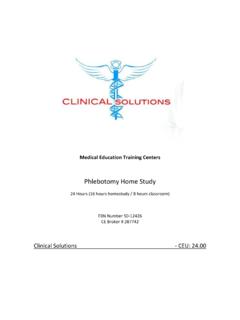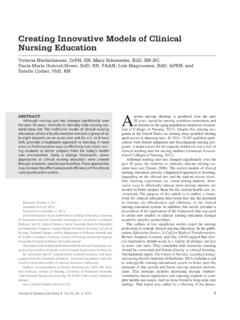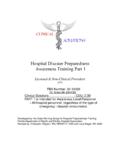Transcription of Pediatric & Adult Moderate Sedation - Clinical Solutions
1 1 Pediatric & Adult Moderate Sedation Created by Terry Jonas, RN FBN Number: 50-12426 CE Broker Number: 20-295403 2 Moderate Sedation Self-Study Module Purpose: This module is designed to enhance awareness of the nurse s role, scope of practice and care when administering and/or monitoring patients receiving Moderate Sedation . This module also includes a discussion of the nursing responsibilities in the event of an adverse reaction or a life-threatening complication. Objectives: Upon completion of this self-study module, the learner will be able to: 1. Define the continuum of Sedation . 2. Differentiate between levels of Sedation . 3. List at least 3 differences in Clinical appearance between Moderate Sedation and deep Sedation . 4. Describe complications and high risk factors of Sedation . 5. Discuss the indications for and the goals of Sedation in children.
2 6. Define pre-procedure, intra-procedure, and post-procedure assessment parameters. 7. Define the ASA classification system. 8. Discuss methods of drug administration and specific agents. 9. List 3 potential complications of Moderate Sedation and describe the nursing interventions. 10. Discuss the Aldrette Score pre and post procedure. 11. List at least 5 criteria for discharge from Moderate Sedation level of care. In order to obtain and maintain competency in the care of the sedated patient, the RN will: Competency in Monitoring of Moderate Sedation : 1. Complete the Moderate Sedation module self-study packet. 2. Attend the Moderate Sedation workshop (one-time mandatory class) 3. Complete Moderate Sedation initial competence checklist for employee file. 4. Review Moderate Sedation self-study packet as per specific department standards. 5. Complete Moderate Sedation competency skill set annually as per specific department standards.
3 6. Must hold current PALS or ACLS certification 3 Introduction This self-learning module is designed to provide the information necessary to administer Moderate Sedation safely and effectively. Moderate (Conscious) Sedation also known as Procedural Sedation refers to Sedation and/or analgesia given under the supervision of a physician to allay patient anxiety and to control of pain during diagnostic or therapeutic procedures. The information contained in this packet follows the established guidelines of Joint Commission ( Standard , , and ), American Association of Nurse Anesthetists, American Society of Anesthesiology, American Society of Peri -Anesthesia Nurses, Association of Peri -Operative Nurses and the Florida State Board of Nursing. The Policies and Guidelines surrounding facilities that administer Sedation are very strict. The American Society of Anesthesiologists Guidelines for Ambulatory Anesthesia and Surgery specifies that at minimum: A licensed physician should be in attendance in the facility at all times during patient treatment, recovery, and discharge.
4 The facility must be established, equipped, constructed, and operated in accordance with applicable federal, state, and local laws. Staff in attendance should be adequate to meet patient and facility needs and must consist of: o Professional staff including physicians, nurses, and other practitioners who are duly licensed and qualified o Administration staff o Housekeeping and maintenance staff The physicians who provide medical care in the facility should be organized into a medical staff. This group will assume responsibility for credential review, delineation of privileges and responsibilities, quality assurance, and peer review. There must be adequate personnel and equipment available to manage emergencies. The facility must have established policies and procedures to handle unanticipated patient transfer to an acute care hospital. Also, patient care shall include: Preoperative instructions and patient preparation.
5 An appropriate history and physical exam by a physician prior to Sedation . Preprocedure studies as indicated. Procedural Sedation shall be administered by or under the direction of a qualified physician. General anesthesia shall be administered by the appropriate anesthesiology personnel. 4 The physician is responsible for directing discharge criteria. Patients must be provided with written postoperative and follow-up instructions. Medical records must be accurate, confidential and current. Definitions Current definitions of Sedation define the following 4 levels: Minimal Sedation (Anxiolysis) is a drug-induced state during which patients respond normally to verbal commands. Although cognitive function and coordination may be impaired, ventilatory and cardiovascular functions are unaffected. Moderate Sedation /Analgesia (Conscious Sedation ) i s a drug-induced depression of consciousness during which patients respond purposefully to verbal commands, either alone or accompanied by minimal tactile stimulation.
6 No interventions are required to maintain a patent airway and spontaneous ventilation is adequate. Cardiovascular function is usually maintained. Deep Sedation /Analgesia is a drug-induced depression of consciousness during which patients cannot be easily aroused, but respond purposefully following repeated or painful stimulation. The ability to independently maintain ventilatory function may be impaired. Patients may require assistance in maintaining a patent airway, and spontaneous ventilation may be inadequate. Cardiovascular function is usually maintained. * Reflex withdrawal from a painful stimulus is NOT considered a purposeful response. Anesthesia 2004 CAMH PC-41 is a drug-induced loss of consciousness during which patients are not arousable, even by painful stimulation. The ability to independently maintain ventilatory function is often impaired. Patients often require assistance in maintaining a patent airway, and positive pressure ventilation may be required because of depressed spontaneous ventilation or drug-induced depression of neuromuscular function.
7 Cardiovascular function may be impaired. 5 The Continuum of Sedation Sedation occurs on a continuum from minimal Sedation to general anesthesia and patients progress along that line based on the medication given, the route, the dose and the patient s own current Clinical status. / / / / Minimal Moderate Deep Anesthesia Sedation (Conscious) Sedation (Anxiolysis) Sedation Moderate Sedation may be administered and monitored by a competent RN. Deep Sedation and general anesthesia are to be initiated only by an anesthesia provider. The non-anesthesia provider caring for the patient must be able to recognize the Clinical differences between the levels of Sedation , and be able to rescue the patient, should the patient progress to a deeper level than was intended. For example, the healthcare provider who is capable of monitoring or administering Moderate Sedation must be able to recognize when that patient has slipped into Deep Sedation and provide any necessary emergency care.
8 This care may include airway support, fluids, more frequent assessments, or an immediate consult with an anesthesia provider or other practitioner with advanced airway skills, if necessary. The following table reviews the levels of Sedation , and their effect upon the patients airway, breathing, and cardiovascular system. 6 LEVELS OF Sedation Level Other Terms Patient Responsiveness Airway Spontaneous Ventilation Cardiovascular Function Minimal Sedation Anxiolysis Responds normally to verbal commands Unaffected Unaffected Unaffected Moderate Sedation Conscious Sedation , Twilight sleep Responds purposefully to verbal commands, either alone or with light tactile stimulation Patent, no intervention needed Adequate Usually maintained Deep Sedation Not easily aroused, but responds purposefully after repeated or painful stimulation May be impaired; intervention may be needed May be impaired intervention may be needed Usually maintained, possibly change in heart rhythm or blood pressure General Anesthesia Not arousable, even upon painful stimulation Often impaired; intervention often needed.
9 Often depressed; positive pressure ventilation usually required May be impaired 7 Goals of Moderate Sedation Reduce the patient s anxiety and discomfort. Change level of consciousness and mood. Maintain a level of consciousness and responds appropriately for level of Sedation cooperate as instructed. Achieve higher pain threshold. Maintain baseline vital signs. Patient returns to baseline functions post procedure. Patient experiences safe and prompt recovery. Unresponsiveness and unconsciousness ARE NOT the objectives of Moderate Sedation . Note: The guidelines used for Moderate Sedation do not apply to patients on mechanical ventilation. PROCESS OF Sedation The process of administering and/or monitoring a patient for Moderate Sedation involves several key elements: 1. Determining if the ordered Sedation falls under the guidelines for Moderate Sedation .
10 2. Determining if the patient is an appropriate candidate for nurse-monitored Sedation . 3. Preparing the patient and the setting. What Moderate Sedation is Not: Sedation given for labor of childbirth Pre-operative medication Postoperative pain relief, including use of PCA 8 4. Patient care during the procedure. 5. Recovery of the patient after the procedure. 6. Discharge from the Sedation level of care. The risk of complications is diminished if all these elements are addressed safely and successfully Is this Moderate Sedation ? A frequent question that arises is how do I know if what is ordered for my patient is Moderate Sedation ? Keep in mind that minimal Sedation (anxiolysis) is mild Sedation that is ordered for relief from anxiety or pain in a conscious patient. The patient is easily awakened by normal or softly spoken verbal commands and is oriented when awake.







